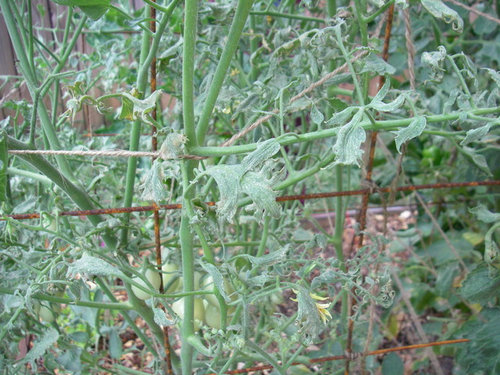tomato issues--Help
aeroflot
11 years ago
Related Stories

EDIBLE GARDENSSummer Crops: How to Grow Tomatoes
Plant tomato seedlings in spring for one of the best tastes of summer, fresh from your backyard
Full Story
LIFEKitchen Traditions: Tomato Season Meets a Family Legacy
Somewhere a Sicilian great-great-grandmother is smiling at a bowl of American-made sauce
Full Story
COLOR10 Reasons to Make a Splash With Tomato Red
You won’t duck at these tomatoes. See how bold red shades can play up architecture, light up a dark spot and add drama
Full Story
ARCHITECTUREHouzz Tour: Fresh Ideas in a Former Tomato Packing Shed
A formerly metal-clad structure is now a beautiful wood home designed to capture the light and preserve open space
Full Story
MOST POPULAR7 Ways to Design Your Kitchen to Help You Lose Weight
In his new book, Slim by Design, eating-behavior expert Brian Wansink shows us how to get our kitchens working better
Full Story
PETS6 Ways to Help Your Dog and Landscape Play Nicely Together
Keep your prized plantings intact and your dog happy too, with this wisdom from an expert gardener and dog guardian
Full Story
GARDENING GUIDES12 Tips to Help You Start an Edible Garden
Get on your way to growing your own vegetables with a raised bed or a few containers on the patio
Full Story
DECLUTTERINGDownsizing Help: Choosing What Furniture to Leave Behind
What to take, what to buy, how to make your favorite furniture fit ... get some answers from a homeowner who scaled way down
Full Story
You Said It: Hot-Button Issues Fired Up the Comments This Week
Dust, window coverings, contemporary designs and more are inspiring lively conversations on Houzz
Full Story
COLORColor Commitment Issues? Just Throw In a Pillow
You don't need to go big or permanent to go bold with color in your rooms; you only need to master the easy art of the toss
Full StoryMore Discussions








aeroflotOriginal Author
aeroflotOriginal Author
Related Professionals
Danbury Landscape Architects & Landscape Designers · Citrus Heights Landscape Architects & Landscape Designers · Essex Landscape Architects & Landscape Designers · Fitchburg Landscape Architects & Landscape Designers · Lakewood Landscape Contractors · Salem Landscape Contractors · Southbury Landscape Contractors · Wanaque Landscape Contractors · Winchester Landscape Contractors · Baker Decks, Patios & Outdoor Enclosures · Gastonia Decks, Patios & Outdoor Enclosures · Novi Decks, Patios & Outdoor Enclosures · Rancho Palos Verdes Decks, Patios & Outdoor Enclosures · Richmond Decks, Patios & Outdoor Enclosures · Saint Louis Park Decks, Patios & Outdoor Enclosuresslowpoke_gardener
djamie
Okiedawn OK Zone 7
aeroflotOriginal Author
Okiedawn OK Zone 7
susanlynne48
elkwc
Okiedawn OK Zone 7
susanlynne48
Okiedawn OK Zone 7